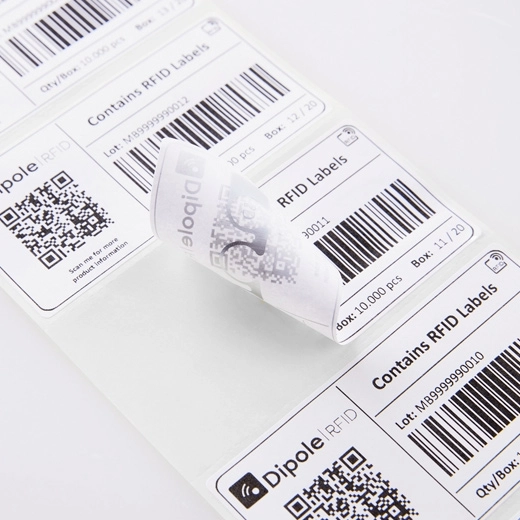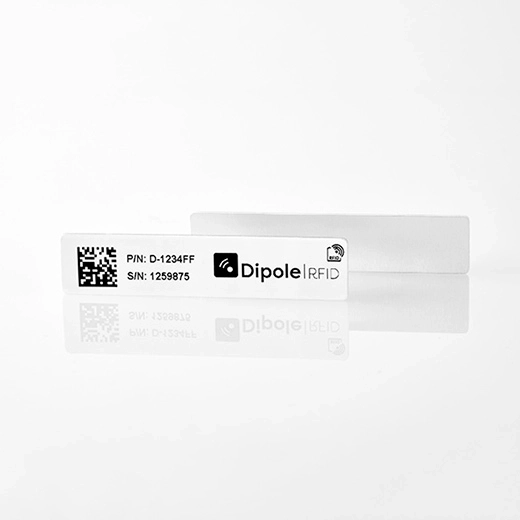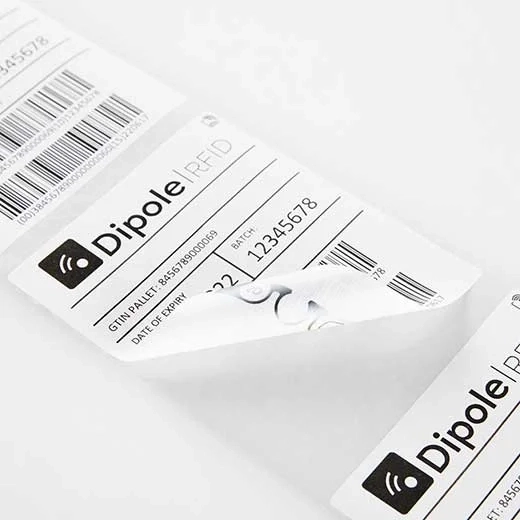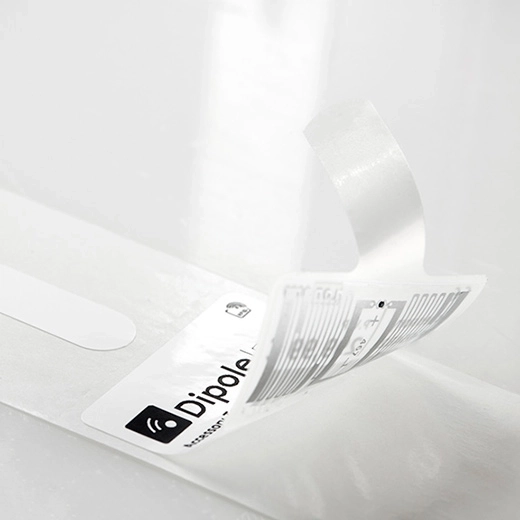RFID Labels: Definition and Applications
Concepts such as digitalization, IOT, industry 4.0, or traceability, are heard more and more frequently among the most diverse sectors. One of the motor technologies for achieving traceability and the digitalization of processes is RFID (Radio Frequency Identification), a wireless communication system that operates through radio signals.
There are a number of different RFID systems, but they all have these fundamental elements in common:
- Labels (which are adhered to the objects we wish to identify)
- Reader (responsible for receiving the radio signal and transmitting it in a comprehensible way to a computer)
- Antenna (which operates as the link between the labels and the reader)
- Software (in charge of the management of the received information)
In previous articles, we have answered questions such as "What is RFID?"; so in this one, we will explain what RFID tags are, what they are made of, and their most common applications.
With the rapid advancement of technology, new functions, applications, and terms constantly emerge, such as "traceability", "Industry 4.0", or "digitization". All these new tools are gradually being introduced into many sectors. The application we want to discuss today is RFID tags.
Their multiple types and easy use, among other aspects, make them the ideal option for many sectors. Since we have already explained what RFID is in another post, today we will focus on the tags of this technology, their composition, and their most common applications.
What are RFID labels?
RFID labels are a simple way to identify a product or object so that it can be wirelessly detected, ensuring traceability. An RFID tag is a small, intelligent device that stores data and can transmit it through radio-frequency signals. The information and traceability it sends about a product can be quickly and automatically captured by a signal receiver.
Despite their small size, they can encode a large amount of information about a product throughout the supply chain. Their data storage capacity allows the item they reference to be traced from the raw material supplier to the arrival of the product at the point of sale, thanks to radio frequency. Company workers can check in real-time and whenever needed all the information contained in the RFID tags. These tags help with stock management, replenishment, and sorting of merchandise.
RFID tags are the foundation of the eponymous system, so selecting the most suitable one for the product is crucial for the system's proper functioning. Each tag has a chip and an antenna. The combination of the RFID chip and antenna is called the RFID inlay. There are three types of RFID tags, with different features and specifications. Their differences lie in whether or not they have their own power source:
- Passive tags: They do not have their own power source, so they are activated by the energy of the external wave created by the RFID antenna and reader. This characteristic makes them short-range tags, and their reading range (0-15 meters away) is limited by the power needed to activate the chip. This is the most common tag, given its size and price.
- Active tags: They have their own power source, so they activate their integrated circuits and constantly transmit a signal. They have a higher reading range (up to 100 meters) than passive tags. These tags are more expensive (due to the cost of their battery and transmitter).
- Semi-active tags: They are a mix of the previous two: they are activated by the signal received from the RFID reader but also have a battery that powers the chip. This allows them to store information and respond quickly and securely. They have a higher reading range than passive tags, but their cost is higher and their lifespan is shorter due to the battery.
What are RFID labels made of?
RFID tags are composed of 3 main elements, which must be of very high quality to ensure the functionality of the components:
- Material or substrate: This is the component that binds the rest of the parts of the tag. It is usually made of a thin and flexible polymer or plastic material. It must be able to withstand the various environmental conditions the tag will be subjected to during its life cycle, so the substrate can be of various types (metal, plastic, cardboard, etc.). It is important to consider that the requirements for proper functioning will not be the same for a tag intended for logistics as for one to be used inside freezers. A protective layer made of materials such as PVC, epoxy resin, or adhesive paper is usually added. This allows the tag to be attached to an object.
- Antenna: This is the largest part of the tag and is connected to the chip. Its shape will determine the frequency at which it operates. It is usually composed of a strip of a conductive material (copper or aluminum), and its mission is to receive signals emitted by RFID antennas and, depending on the type of tag, transmit or reflect the received signal (in an active tag, the signal is transmitted back, and in a passive tag, it is reflected). To choose the best antenna, we will have to consider the reading processes that the product in question will be subjected to during the supply chain.
- RFID chip: This is an integrated circuit (IC) that has a memory store and a microprocessor for decision-making. It needs energy to function, so in passive tags, the chip is designed as a passive power device. It obtains energy from radio waves radiated by the RFID system's antenna. In active tags, this energy usually comes from a battery in the tag itself. There are many options for memory capacity and security. For most applications, a low-capacity chip (from 128 bits) is more than sufficient.
Types of RFID labels
It is essential to select an appropriate RFID tag for the product and the environment in which it will be used. That's why there are different types of tags based on their application. At Dipole, we work with the necessary standards to ensure that all needs are covered with our RFID tags.
That's why we have a wide variety of materials (standard paper, polyethylene, polyamide, cardboard, etc.) to manufacture the tags, as well as multiple delivery formats (in rolls, zig-zag, loose, etc.). The types of RFID tags we have available at Dipole are:
- Standard RFID labels: The customization of materials, dimensions, integrated circuits, or memory, among other features, make them perfect for various applications. They comply with international standards and are printable on any standard printer in the market. Dipole designs and manufactures standard RFID tags in different sizes and materials, in addition to having numerous internal circuits (IC) and memories depending on each need. They can be used in logistics, industrial processes, plastic containers, etc.
- Rugged RFID labels: As the name suggests, these tags can withstand complex conditions and both internal and external environments. Their design is intended for long-lasting products such as boxes, pallets, or automotive components exposed to high temperatures, chemicals, or water.
- RFID timing labels: Their ability to resist moisture makes this tag the best choice for sports timing, whether for the bib or the shoe. Dipole's RFID timing tags are designed with optimal materials such as foam or plastic and use adhesives resistant to moisture and conditions found in these types of events. Dipole's timing RFID tags stand out not only for their resistance and reliability but also for being the thinnest and most precise on the market, with thicknesses ranging from 0.25 to 5 mm. They can all be encoded on any RFID printer in the market.
- RFID labels for metals: RFID tags for metals are designed to optimally identify and be easily detected on any metal element, avoiding the interference this material causes in radiofrequency waves. At Dipole, we have this type of RFID tags, specially designed for the metallurgical, automotive, aviation sectors, etc.
- RFID labels for retail: At Dipole, we have heat-sealed tags, textile tags, hang tags, etc., to cover different needs for footwear, clothing, or accessory manufacturers. Retail tags are among the most used thanks to the great benefits they bring to the sector. Our customization services in printing and encoding RFID tags enable the brand identity to be conveyed to the consumer and product information to be collected.
- RFID labels for vehicles: These tags are used in access control, presence control, vehicle verification, tailor-made logistics identification, etc. Identifying vehicles with RFID tags can help streamline logistics processes and passage through gates. It ensures reliable traceability and detection. It is necessary to ensure that RFID tags are designed for all types of vehicles, from cars or trucks to buses. Also, the materials used must not leave residues and must withstand external environments.
- RFID labels for laundry: Although it may seem a bit strange, RFID tags in laundries can save a lot of work. At Dipole, we design them with textile products and the industrial washing process in mind. That's why we have created resistant and flexible tags that can adapt to all garments.
- RFID labels for laboratories: Laboratory tags must meet very strict requirements. They must be designed to withstand the chemicals that may be present in a laboratory, freezing temperatures, and high temperatures to identify materials, samples, and products that require specific features. RFID identification ensures identification and tracking without the need for direct vision and in an automated way.
How are RFID tags printed?
RFID tags are printed on a specialized printer for RFID label printing. This printer can be a thermal or inkjet printer, and it is necessary to have access to specialized software for designing and customizing the tags. To print, the label is placed in the printer, and the printing process is followed using the software. The software is responsible for writing the information on the RFID tag, as well as printing the design and necessary information on the label's surface.
It is important to follow the instructions and recommendations of the printer and label manufacturer to ensure high-quality printing and proper functionality of the RFID tag.
There are many printer models, capable of adapting to industrial, desktop, portable environments, and more:
- Industrial: These printers have a high-performance capacity, as they are designed for industrial environments where they will be in operation for long periods (manufacturing, industry, warehouses, logistics processes, asset tracking, shipping, and receiving). At Dipole, we have printers capable of encoding all types of labels and sizes with great flexibility.
- Desktop: The perfect printer for medium or low volume printing. Its use is generally focused on encoding RFID tags and wristbands for hospitals, retail, entertainment, inventory, etc. Its compact form makes it ideal for indoor areas.
- Card printers: These RFID card printers with identification can provide easy and reliable personnel, user, or customer tracking. They feature plastic printing on one or both sides to create gift cards, financial cards, or personal credentials with excellent photographic quality. Their ideal applications would be for medium or high volume environments (sports events, concerts, building security, healthcare, etc.).
- Portable: The best option if you want to increase process productivity since workers can take them anywhere. They are designed for low-volume mobile printing solutions, thanks to their lightweight and compact design. They are mainly used in retail for labeling boxes or pallets, shipping and receiving, transportation management, or document traceability.
- Color: Perfect for printing and encoding RFID tags at high speed and with maximum resolution. They are considered industrial or desktop printers and are mainly used in warehouses, logistics, order picking, and/or packaging, etc.
How long does an RFID tag last?
RFID tags and technology, like any other electronic system, can malfunction due to equipment failures, software defects, environmental influences, or the natural aging of components. The tag, being the most delicate element, is usually the most affected by all these circumstances. To analyze their performance, duration, and the differences that may exist between them, it is necessary to investigate the most common failure modes:
- High electrical resistance between the chip and the antenna, caused by corrosion or oxidation of the conductive adhesive that connects them.
- A break in the integrated circuit.
- The breakage of the connection between the chip and the antenna.
- The antenna may fail due to metal fatigue.
To estimate the approximate duration of RFID tags, manufacturers perform various aging tests. These tests allow them to predict degradation and response levels over long periods. These experiments are monitored and accurately reproduced, so they can be compared with each other.
The performance of RFID tags determines the system's operation and represents a significant investment for the company. Therefore, it is logical to demand the highest quality from tag manufacturing companies. You can ask the following questions to suppliers:
- Have the tags undergone an aging test?
- What method was used?
- Can the results be reviewed?
RFID label applications
RFID technology can be used in a wide variety of processes and sectors. More and more industries are adopting this identification system. Here are some examples of RFID technology and its potential applications:
Supply Chain Management
One of the fundamental applications is improving the overall supply chain by automating, simplifying, or even eliminating identification and data capture tasks at various points in the chain, ensuring traceability. RFID tags are placed on all products to be tracked, providing information about them at each stage of the process. This simplification leads to benefits such as increased productivity and efficiency and reduced operational costs.
Industry
To be competitive today, it is essential to improve production times, reduce direct labor in non-value-added processes, and increase overall company productivity. The industrial sector has found RFID technology to be a great ally, offering advantages such as data capture in procedures where it is impossible or costly to do manually. It has streamlined and optimized all processes within industrial activity, with many sectors incorporating it into their systems.
One example is the automotive industry: many car manufacturers and component suppliers use this technology for a comprehensive view and control of the supply chain, managing assembly lines more easily, detecting errors, and storing important information about each piece (such as serial number or manufacturing date) thanks to RFID tags. This ensures complete traceability of their products and simplifies interactions between various supply chain actors, from material suppliers to dealership agents.
Logistics
Logistics processes have experienced positive change due to RFID systems: the interaction between manufacturing, distribution centers, and stores is much more agile and effective. Goods can be identified massively and reliably, avoiding manual information verification. Warehouse management is improved, allowing automated loading and unloading of goods. Order preparation, packing, and collection times are reduced, and errors are easily detected.
By applying radiofrequency to logistics, businesses gain a global view, ensuring good service and increasing productivity by 20-30% more than using barcodes.
Retail
Retail is one of the sectors that has benefited the most. Adhesive RFID tags placed on products allow the exact location of each item to be known at all times, as well as storing relevant information about them. This greatly simplifies inventory management, preventing stockouts. These tags can also be used as anti-theft systems, only deactivated when passing through the checkout; a detection gate will sound an alarm if someone tries to take a product without paying.
In addition, this technology can offer customers a new shopping experience through interactive screens and fitting rooms, which allow for product identification and information, purchase recommendations, or requests for different sizes and colors, among other options.
Overall, RFID is a useful tool for improving customer satisfaction and increasing sales volume. Fashion, jewelry, and cosmetics are some of the sectors where this technology has become indispensable.
Today, RFID technology is the best system for tagging clothing and other retail products in an easy, fast, and effective way.
Hospitals / Pharmaceutical
Industry Hospitals also collect large amounts of data daily, essential for the proper functioning of all treatments performed there (patient admissions and discharges, medical supplies, medications, access data to restricted areas for hospital staff, etc.). Collecting all this data requires a system capable of storing and updating it immediately, simply, and securely. Thus, the benefits and tools of RFID technology:
-
- Patients are identified at all times, thanks to RFID wristbands and other systems such as RFID tags in their medical records.
- The hospital itself is more secure, as it has constant control over both product inventory and facility users.
- Search and manual note-taking times are eliminated.
Food and Drinks
One of the primary concerns of the food industry is the sanitary safety of products. RFID technology offers numerous advantages in ensuring food traceability at any stage of the production process:
It allows product entries from the field with alerts for ripening time or other associated processes; temperature control in the cold chain; movement registration between drying chambers/curing zones; and even controlling turnovers in cheese curing processes and similar products. We can also create alerts to prevent obsolete or expired stock.
In addition, with RFID tags, we can store all the information that must be included about the products (entries, sizes, varieties, etc.), ensuring compliance with current legal regulations.
Libraries / Documents
RFID tags provide books and/or documents with a unique identification number, allowing for more accurate and effective tracking since the system can read the identification of multiple units simultaneously and avoid manual identification. Additionally, this technology is used for the authentication of official documents, preventing forgery. Implementing RFID technology in a library enables real-time registration of book loans and returns and control of due dates. Users can access the information they need at any time. With this system, a library user could check from home if a book or CD is available at the library or not.
Sports Timing
RFID technology allows for better management and control of participants times in races and other sports events. The RFID tag assigned to each participant enables tracking of their course and timing. These disposable tags allow for accurate timing without causing any discomfort to the athlete. They can be attached to the bib, sports shoes, or other clothing worn by the runner.
Identification and Location of Assets
We can record asset movements in real-time, enabling control and management on-site or from a remote location. By identifying assets with appropriate tags, we can easily locate them even if they have been moved and placed where they do not belong. We can even record changes in environmental conditions for critical products.
These systems help prevent asset loss or misplacement while simplifying management and reducing operational costs.
Inventory Management
Proper inventory management is essential for the smooth operation of any business.
With RFID technology, we can manage the inventory process in real-time, automatically: we can assign a unique identifier to each stored product, avoiding duplicates and discrepancies; we can easily obtain relevant information about stored products and their location; and we can maintain a more accurate and constantly updated stock.
This way, we can save time and reduce costs while increasing productivity, avoiding errors, and preventing unnecessary expenses.
Access Control
This is one of the most common uses of this technology. With an RFID tag, real-time and rapid control of products entering and leaving a warehouse or people participating in an event can be achieved. To do this, RFID portals can be placed at access points, capable of identifying the number of tags passing through them and their carrier.
Companies can obtain a wealth of information for the management and control of activities. Examples include, but are not limited to, goods entries and exits, order distribution (the entire process), worker identification and access, event entry supervision, door locking in hotels, and many more.
How much the RFID labels?
There are many factors that influence the price of an RFID tag: the type of chip, the dimensions of the tag, the material type, the adhesive, the quantity demanded, the memory, the packaging of the tag itself, etc. Their prices will vary according to these elements; they can range from a few cents to higher amounts.
The best way to know the ideal price for your RFID tag is to contact one of our experts at Dipole. They will advise you on the best option for your needs and guide you throughout the entire process.
At Dipole, we encourage you to learn about all these technologies and integrate them within your company's needs and strategies. That's why we offer you all our intelligent RFID identification services. With these solutions, we can provide real-time, reliable, and live data to make informed decisions about your business. If you want to learn more about our services, don't hesitate to contact us and continue reading about all the technological innovations on our blog.
Related products
Contact Form
We can help you?
Find the RFID product or solution that meets your business needs.
Ask us to help you find the right decision.




